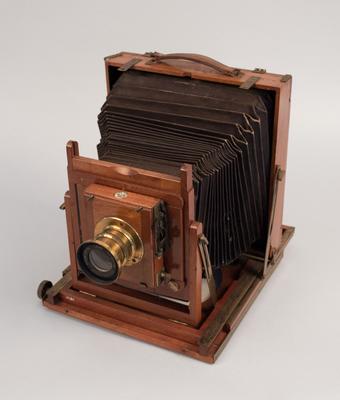Camera [Imperial Triple Extension]
Maker and role
Thornton-Pickard Manufacturing Company Ltd, Manufacturer
Production date
Circa 1904-1910
See full details
Object detail
Accession number
1965.152
Description
Thornton Pickard Imperial Plate Camera. Known as a triple extension camera, the lens panel and bellows "rake" out to an extra length enabling close-up focussing on very small objects. Stand camera, with a circular space in the baseboard for tripod attachment.
This camera has a Beck symmetrical (rectilinear) lens, but other lenses of different focal lengths and apertures can be readily substituted. The shutter is of the "roller blind" type patented by Thornton-Pickard and adopted by many British camera manufacturers of the day. First marketed in the early 1900s, this type enjoyed wide popularity with both amateurs and professionals alike.
This camera has a Beck symmetrical (rectilinear) lens, but other lenses of different focal lengths and apertures can be readily substituted. The shutter is of the "roller blind" type patented by Thornton-Pickard and adopted by many British camera manufacturers of the day. First marketed in the early 1900s, this type enjoyed wide popularity with both amateurs and professionals alike.
Brief History
The Thornton-Pickard Manufacturing Company was formed in 1888 in Manchester, moving to Altrincham in 1891. John Edward Thornton, who founded the company’s predecessor, Thornton Manufacturing Company in 1886, patented improvements to photographic equipment including field cameras and shutters. The company was well known for its roller blind shutters.
The Imperial was a stand or field camera, with both double and triple extension models and made for a variety of plate sizes. It has been described as a ‘mid-range’ camera and was popular for outdoor photography. The whole plate model was introduced in 1904.
The Imperial was a stand or field camera, with both double and triple extension models and made for a variety of plate sizes. It has been described as a ‘mid-range’ camera and was popular for outdoor photography. The whole plate model was introduced in 1904.
Marks
THORNTON. / TRIPLE / "IMPERIAL" / EXTENSION / PICKARD Maker's Mark
SYMMETRICAL LENS THORNTON PICKARD-BECK Maker's Mark
SYMMETRICAL LENS THORNTON PICKARD-BECK Maker's Mark
Media/Materials
Credit Line
Thornton-Pickard Manufacturing Company Ltd. Circa 1904-1910. Camera [Imperial Triple Extension], 1965.152. The Museum of Transport and Technology (MOTAT).
Related exhibitions


Public comments
Be the first to comment on this object record.